Sarnath is a holy city near Benaras or Varanasi (The oldest city of the world). Sarnath (also known as Mrigadava, Mrigadaya, Rishipattana, Ishipattana) is the land where Buddhism started its journey that is the concept of “Sangha” was founded.

Sarnath or Ishipatana is one of the four holiest sites of Buddha Circuit mentioned by Prophet Goutama Buddha (Tathagata, Bodhisatwa) where his devout followers must visit for pilgrimage. Other three places are Lumbini (Where the Prophet was born as prince Siddhartha), Bodh Gaya (Where prince Siddhartha attained enlightment and became Tathagata) and Kushinagar (Where he passed away).
Reason behind the name of Sarnath:<
According to mythology, when Prophet Buddha was born, devas (Gods) came down to announce it to 500 holy men. The holy men rose into the air and disappeared and their relics fell into the ground. So, the name Rishipatana (Rishi means Holy men and Patana means drop) was derived. Ishipatana is the mispronunciation of Rishipatana.
Tha name Mrigadaya means deer park (Mrig means deer) in Pali. When Tathagata came here it was a forest given by the King of Varanasi.
According to Hieuen Tsang, it was quoted in Nigrodhaing Jataka that deers were allowed to roam around this place.

The name Sarnath has been derived from the Sanskrit word Saranganatha which means “Lord of the deer”. One legend says that once upon a time Bodhisatwa was born as a deer.
Surprisingly the deer park still exists as a silent witness of history.
History of Sarnath:
Dear reader, before saying about my day out I would like to do a quick time travel with you and cover a golden era from X BCE to 12th ACE.
The time of Rishipatana starts at the age when King Bimbisara ruled from Pataliputra. After attaining enlighment, Tathagata started his journey to Rishipatana from Bodh Gaya and started finding his five former companions. He arrived at the deer park of Rishipatana and taught what he has learnt during his enlightment.
On a full moon night of Ahalya Puja, he delivered his first discourse to those five (said above) as known as Dharmachakra Pavatta Sutta and at that moment the “Sangha” was founded.
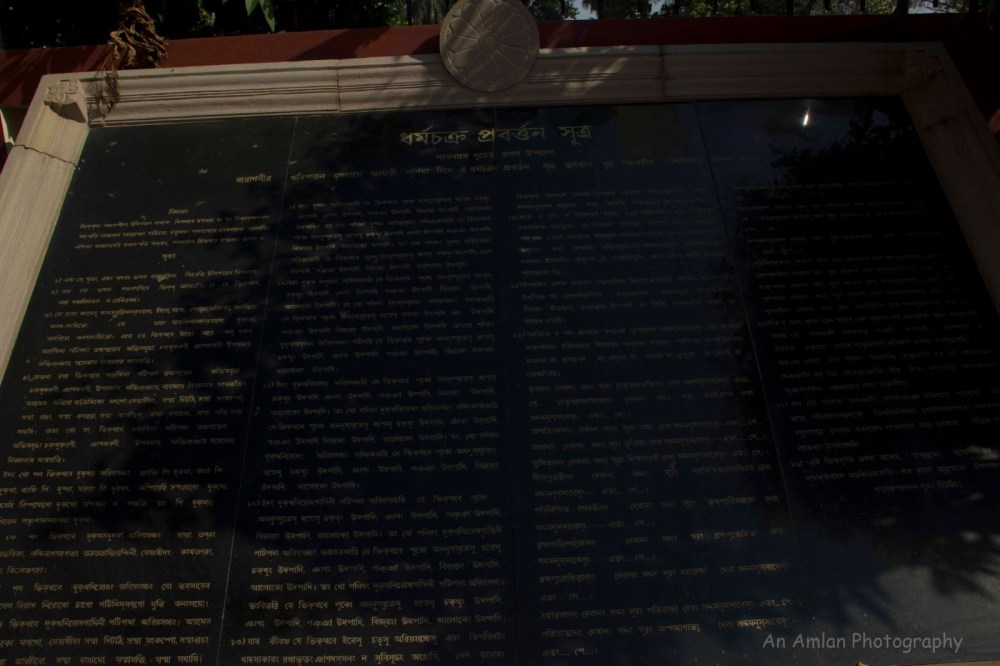
Beside to Dharmachakra Pavatta Sutta, he preached some other Suttas like Dharma Sutta.
Buddha spent next rainy season at Sarnath and the member of Sangha got increased to 60.
The supportive king and the wealthy merchants helped Buddha religion to flourish. Within next centuries Sarnath had become an important center of Arts. The King also found 30 monasteries. According to Hieuen Tsang, 1500 monks were there at Sarnath.
King Ashoka commissioned a Stupa at Rishipatana at 249 BC that indicated the location of his offering to Buddhism. On 500 ACE the iconic Dhamek Stupa was established to replace the old one. Detail about Dhamek Stupa will be discussed later.
At the end of 12th Century ACE, Sarnath was attacked and almost destroyed by Turkish vandals. The ruins were gradually destroyed until 1836 when British started excavation.
My day out at Sarnath:
Usually Sarnath is a day out tour from Varanasi. So like other tourists we went to Sarnath from Varanasi. Our driver wanted to drop at a newly created temple that contains a gigantic Buddha statue and tried to convince that this one is the original place of Sarnath. I knew that he was bluffing, so I contacted to the travel agent and escalated about the driver, then he dropped us at the bus stand.
On the opposite of the bus stand there is a Buddha temple – Mulagandha Temple. Here prophet taught his lessons to the closest peers. The holy place is marked by a model and the original “Pavatta Sutta” is written in Pali, Sanskrit, Bengali, English and Hindi.
After viewing them we came out of it and went to the main excavation of Sarnath. The excavated area is gigantic and larger than life.
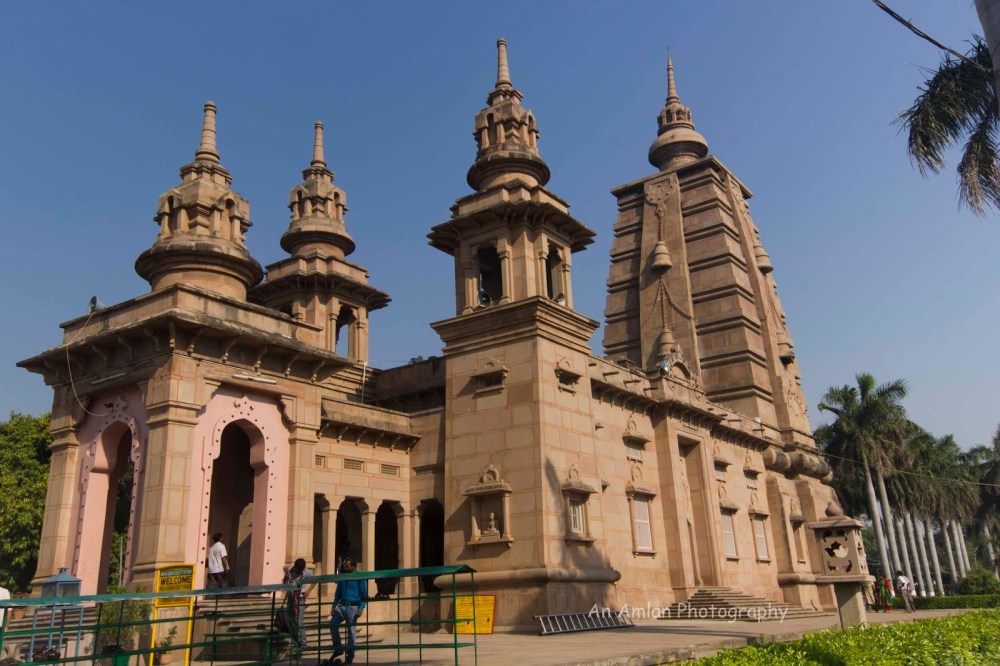
Let’s start travelling inside the main excavation.
Monastery V:
On the right hand side of the gate of main excavation, the ruin of Monastery V is located. It contains an open courtyard, a series of cells on four sides and a wall in the center of the court. It is example of the Chatuhsala-Sangharama.
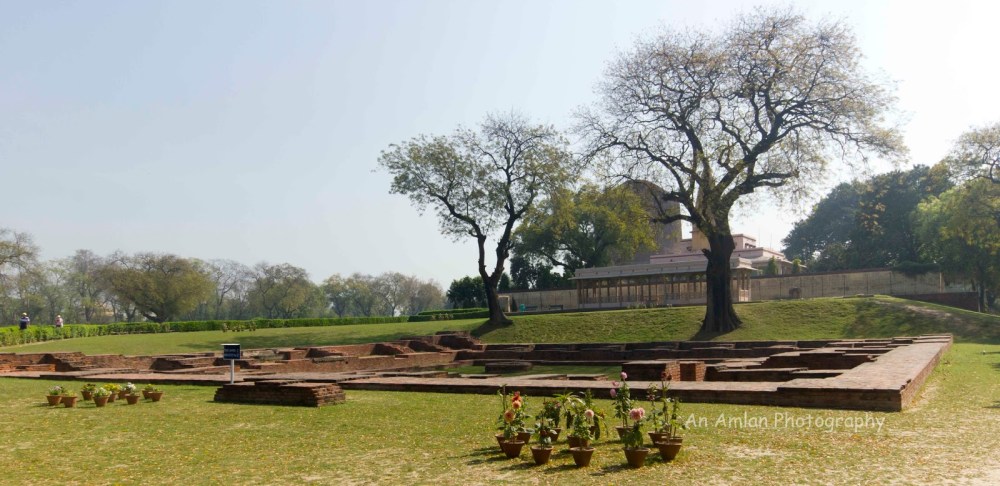
This structure gives a brief idea about the usual type of monasteries in Gupta age.
Monastery VII:
On the opposite of Monastery V, the ruin of Monastery VII is found. It is believed by the archaeologists that the monastery was constructed at the early days of medieval period.

There is nothing much to see here. Let’s walk straight as something very interesting is getting there.

A group of Votive Stupas:
From Monastery VII I walked straight towards a cylindrical ruin, on the way a huge number of votive stupas are there.
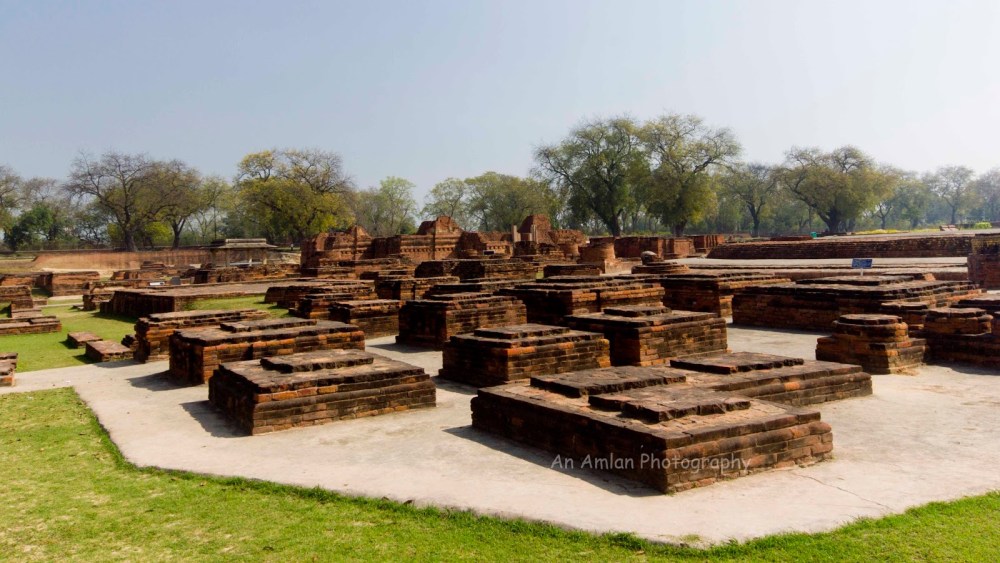
Dharmarajika Stupa:
Next to Votive Stupas, the ruin of cylindrical Dharmarajika Stupa is present.

I think, the above photo is fair enough to get the idea of the rounded structure. The original structure was raised by the great king Ashoka, the first addition was made by Kushan period with brick, the second enlargement came with the addition of circumambulatory path in the fifth or sixth century AD and the third enlargement was done in seventh century. Fourth and fifth enlargements were made in ninth to eleventh century, The sixth and the last encasing was done in twelfth century.

Two iconic images – Buddha seated in the attitude of preaching and the colossal red sandstone Bodhisatwa were found here. Now the images are placed in the adjacent ASI museum. This is a very holy stupa for Buddhists.
Main Shrine (Mulagandha Kuti):
Main Shrine is located on the north of the Dharmarajika Stupa. It is a temple surrounded by a concrete pavement. This is Mulagandha Kuti. According to Hiuen Tsang, it was about 60 meter in high. The temple was built in bricks and plaster with a mingling of carved stones from earlier structure.

Excavators state that the Shrine was first constructed in 2nd century BC and then further construction was done in Gupta age.
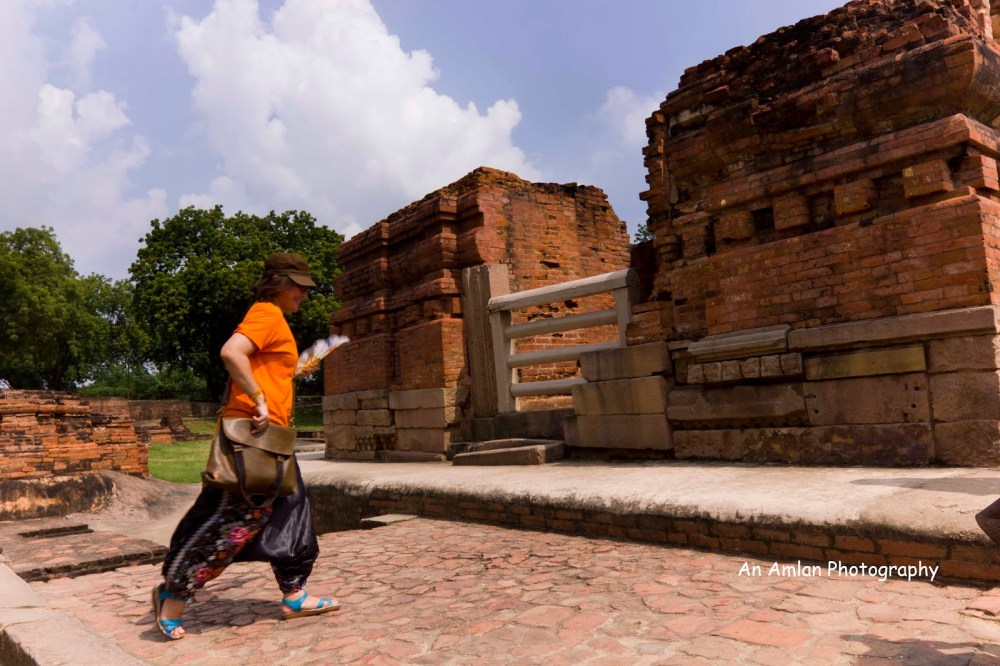
Ashokan Pillar:
Ashokan Pillar is locates at the east side of Main shrine. Right now, there is only a replica of the original pillar is there, the original pillar is kept at the adjacent ASI museum. This pillar is the national emblem of India.
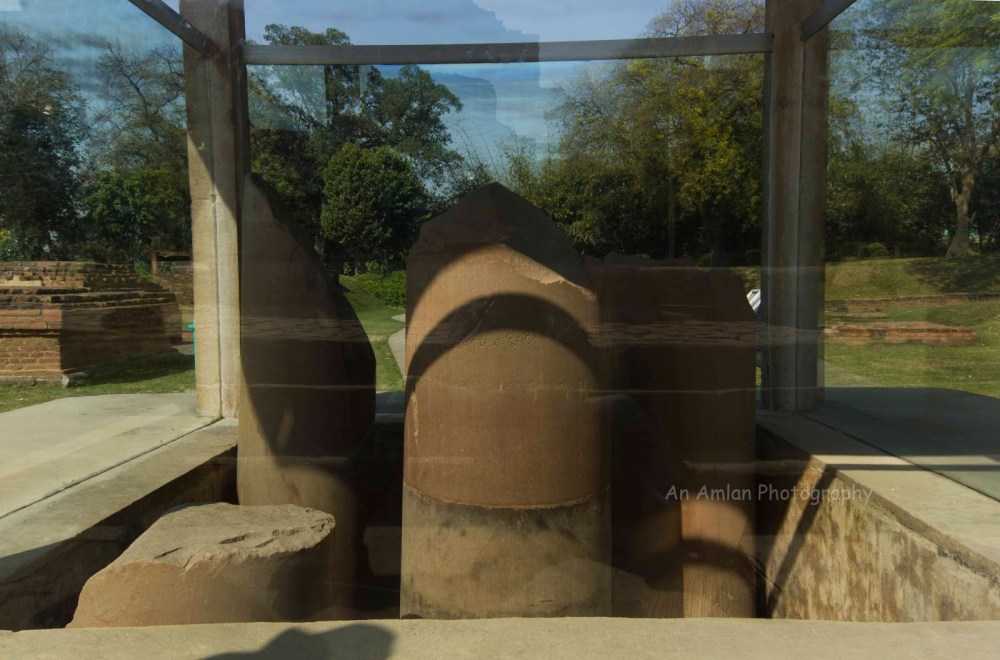
Dhamek Stupa:
This is the iconic architecture of the Sarnath. The gigantic solid cylindrical was constructed in Gupta age. It is 24.06 meter high and its diameter is 33.53 meter. The structure consists of a circular stone drum to a height of 11.20 meter resting on a ground without usual rectangular basement. The stones of each layer are bonded by iron clamps. The magnificent structure reflects the richness of engineering and art of ancient India.
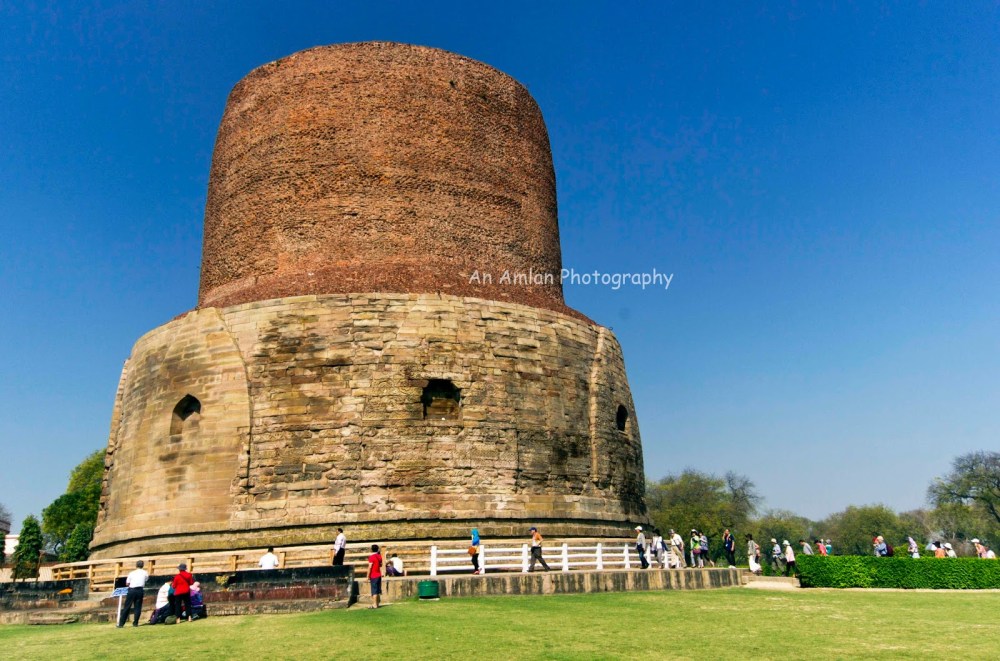
Geometrical, floral patterns combined with birds and human figures, depicted to its body makes everybody spellbound.

Other monasteries:
Monastery I, II, III, IV was not open for public when I visited there as some maintenance was going on. Even in my second visit they were not open to public. Hopefully, next time I will be able to see them.

Chaukhandi Stupa:
Another great example of ancient Indian architecture is Chaukhandi Stupa. But this is outside of the main excavation site. Due to time constraints I could not go there.
ASI Museum:
The museum is a must visit place. The sculptures and living accessories found during the excavation is properly conserved in the museum. Camera is not allowed inside the museum.
Suggestions to the honorable readers:
- My suggestion is to skip other places and spare at least 6 hours inside the monasteries. Please talk to the driver about this plan. Please do not tell them that you are going to stay there for six hours. Just tell them that you are interested for Sarnath only.
-
The drives of cab and auto rickshaw will take you to some newly created monasteries in Sarnath and will make you fool. They are very beautiful but do not go there at the beginning. Though they are nice with feel good factors but the original Sarnath is the place that I have said in this post. If possible, show some pictures of Dhamek Stupa to them and ask that you want to go there.
- Please do not sit on the wall of excavation site.
- Taxi drivers of varanasi will try to make you fool by misguiding, do not listen to them and plan according to your wish.
Going:
Sarnath is included in the day tour package from Varanasi. Honorable readers, again I would like to suggest you to skip other places and spare at least 6 hours inside the monasteries. Please talk to the driver about this plan.
Staying:
There are lots of hotels in Varanasi starting from INR 500 per night to INR 10000 per night. Please choose according to your budget.
Reference:
- Sarnath Archaeology, Art & Architecture by Archaeological Survey of India

I’m impressed, I have to say. Really not often do I encounter a weblog that’s each educative and entertaining, and let me let you know, you will have hit the nail on the head. Your idea is excellent; the problem is one thing that not sufficient persons are speaking intelligently about. I am very glad that I stumbled throughout this in my search for something regarding this.
LikeLiked by 1 person
I got what you mean ,saved to my bookmarks, very nice website .
LikeLiked by 1 person